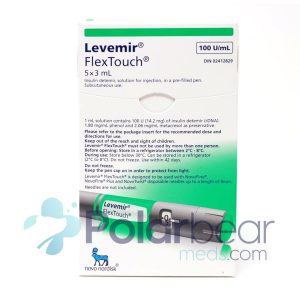Levemir vs Lantus

Today, more than 34 million Americans live with diabetes, almost 11% of the country’s population. An American is newly diagnosed with diabetes every 17 seconds.
When most people are diagnosed with diabetes, their doctor will typically prescribe Levemir (insulin detemir) or Lantus (insulin glargine) to manage their condition. Levemir is manufactured by Novo Nordisk and Lantus by Sanofi. Having to begin injecting insulin daily can be frightening. But, injecting insulin is much simpler than people imagine.
Both Levemir vs Lantus are brand-named insulins and classified as “basal” insulins. Both are created by modifying human insulin and are clear solutions. They are long-acting drugs that work over 24 hours in the body and are usually only injected once a day. They work by moving glucose through the bloodstream into cells. This helps regulate blood sugar levels and prevents them from getting too high.
But patients are often curious and unaware of any differences between the two Levemir vs Lantus insulins. Patients routinely ask if there are, in fact, differences. If so, what are they? And which of the two medications is more effective in treating diabetes? Here’s what you need to know:
Both Levemir vs Lantus are FDA-approved. Levemir is approved for adults and children aged two years or older with type 1 diabetes and for adults with type 2. Lantus is approved for adults and children over the age of six and for adults with type 2. Compared to other insulins on the market, both have a lower risk of causing hypoglycemia, which lowers blood sugar levels to dangerous numbers. Since Levemir vs Lantus work slowly over 24 hours, patients experience more predictable blood sugar levels. And these medications do not require users to plan their daily dose around meals.
Levemir vs Lantus come in 2 formats: a pre-filled pen injector or a vial. Levemir’s pen injector is called the FlexTouch pen. It features a non-extending dose button and a low injection force. This means it is easier for patients to perform injections regardless of the dose. There is also an “end-of-dose” click so patients can be assured that dose delivery is accurate. Lantus’s insulin pen is called the SoloStar.
It delivers a patient’s precise dose that dials after each use. SoloStar features tiny, thin needles, so discomfort when injecting is minimal. The insulin can be administered by pressing the push-button injection, so patients do not have to stick themselves. It also has a large print dosing window for easy viewing.
Whichever a patient’s preference is, both Levemir vs Lantus are available. Neither should ever be used in an insulin pump as it can cause severely uncontrolled blood sugar levels. Despite all of the similarities, there are some key differences between the two insulins that diabetic patients may want to consider before making a choice.
1. Levemir vs Lantus Directions and Life Cycle
A patient’s dosage of either Levemir vs Lantus insulin will depend on several factors: the type and severity of the disease, a patient’s age, and weight, and any other medical conditions a patient has.
One of the most significant differences is how often each medicine needs to be injected. Lantus is typically taken once a day in the evenings. Though some patients are okay taking Levemir once a day, some need to take it twice. Lantus passes through the body in the same fashion for everyone who uses it. Lantus takes the same amount of time to be processed through the body for all who use it. Levemir does not work in the same way. Some patients can process Levemir a lot quicker than usual. Scientists are not sure why this occurs, but certain patients have to take two injections a day vs. just one.
In addition, Levemir has a much longer shelf life than Lantus. Levemir lasts for 42 days once opened, but Lantus only lasts for 28 days. Both insulins need to be stored correctly, so the medication is not damaged. Unopened insulin should always be stored in the fridge on its side. The fridge’s temperature should be kept between 36- and 45-degrees Fahrenheit. The temperature should not be kept any lower as the insulin could freeze. And avoiding storing in direct sunlight is also recommended.
2. Levemir vs Lantus Side effects
Mild side effects have been reported by both Levemir vs Lantus users. Many patients experienced headaches, nausea, back pain, upper respiratory tract infections, and peripheral edema. The most common side effect is hypoglycemia, but patient levels typically do not reach dangerously low levels.
Levemir is more likely to cause reactions at the injection site. Doctors have also found that more patients wind up discontinuing Levemir than Lantus.
Comparing the side effects, 22.6% of Levemir users experience headaches compared to only 5.5% of Lantus users. However, 12.8% of Lantus users experienced back pain compared to Levemir’s 8.1%. Both Levemir vs Lantus insulins also have serious but rare effects that have been reported. One of Lantus’s serious adverse effects is hypokalemia. Hypokalemia is when potassium levels drop so low that it leads to heart rhythm problems. Adverse effects in both medications include hypoglycemia and severe allergic reactions.
3. Levemir vs Lantus Effectiveness
Lantus is absorbed slowly by the body, and its medicinal effects are prolonged. This is because Lantus is not as soluble as Levemir. This gives Lantus a longer duration of action, and the insignificant peak effect helps patients feel consistent insulin levels. Levemir is more soluble, and the body absorbs the insulin quickly. Quicker absorption may be part of the reason some patients need to inject Levemir twice a day.
Some factors can speed up insulin absorption, and some delay absorption. Some factors that speed up absorption include injecting into the thighs or arms, high temperatures after a hot shower or bath, and massaging around the injection site. Factors that delay absorption include cigarette smoking, over-use of the same injection site, and insulin that is cold.
Clinical studies have compared treatment effectiveness and concluded that people who took Lantus once a day had their hemoglobin A1c reduced by 0.5%. In comparison, Levemir users who used the medication twice a day had their A1c levels lowered by 0.6%. Overall, the margin of difference in the efficacy of both medicines is minimal.
4. Levemir vs Lantus Cost and Coverage
Both Levemir vs Lantus insulins are usually covered by insurance, but neither are covered by Medicare Part D. Both are generally in the same coverage tier on their prescription drug plan, but some insurance plans may cover one brand and not the other. Like most insulins, both can be very expensive without insurance. Out of pocket, a pack of Levemir injection pens cost about $560, while a box of Lantus pens costs around $510. The typical Medicare copay is $532 for Levemir and $489 for Lantus.
5. Levemir vs Lantus Interactions
Certain drugs can interact with these two insulins and increase the risk of low blood sugar. There are some beta-blockers, for example, that can mask the symptoms of low blood sugar. There are also other types of medication that can decrease the blood-glucose-lowering effects of the insulins.
Even though Levemir operates by binding to protein, harmful drug interactions are extremely unlikely. Some studies have suggested that Lantus has more of a significant effect on mitochondria. Though both medications have been proven to be highly safe, most side effects are mild for those who do have them.
Overall, there are differences between Levemir vs Lantus that should be considered before a choice to start one of them is made. The formulations, peak concentration time, and side effects should all be considered. If you are considering one of these drugs, discuss the benefits and disadvantages with your doctor.
The best drug for any diabetic patient needs to be determined by their healthcare provider, who can consider their medical conditions and medical history. Healthcare providers will also be aware of any drug interactions between what a patient is already taking and the insulins. No matter which form of insulin a patient chooses, all package inserts and information should be read carefully.
When patients start taking either Levemir vs Lantus insulin, their doctor can help with education and support. Patients are taught how, where, and when to inject insulin and rotate injection sites to avoid skin thickening. Patients will also be educated on how to store the insulin safely and how to keep a record of blood glucose levels and insulin doses. Consistent monitoring of blood sugar levels will be necessary.
All numbers should be reported to a patient’s doctor, who can then determine if the best dose is being given or if adjustments need to be made. The starting insulin dose a patient begins with doesn’t usually stay the same dose over time. Insulin doses may need to be changed for various reasons, like weight loss or gain, new medications, or illness.
In conclusion, making the best choice for your health and needs can be achieved through knowledge of your condition, communication with your doctor, and being diligent about any effects your medication has on your body. Diabetes may be a chronic disease, but it can easily be managed, and your quality of life doesn’t have to be affected.


